|
|
Search for
The Famous Blonger Bros. |
|

September 2005
| 9/1/2005 |
Take This Ballot Box and Stuff It, Part III
Lou and Sam may not yet have been at the top of the heap in 1890, but they were no strangers to election day hijinks. Rewind to Sam's campaign for constable in Albuquerque, 1882:
Albuquerque Evening Review, November 4, 1882
Santiago Baca went out this morning, with quite a large crowd, on an electioneering trip. Among the party were Judge McComas, District Attorney Owen, Johnny Campbell, Lou Blonger, and a large number of Americans and Mexicans. The procession was headed by a black wagon drawn by four black horses, and a great many persons, seeing it from a distance, thought it was a funeral procession.
Albuquerque Evening Review, November 7, 1882
Lou Blonger challenged two votes by mistake this morning, the men whom he had intended to challenge having already deposited their ballots.
These comments are more interesting than they seem at first glance. Here we see Lou siding with Baca in his quest to be sheriff (running against Perfecto Armijo).
At any rate, this note from Baca on November 5th underscores the relationship between those hired as law officers and the businessmen who paid them:
TO THE PUBLIC.
I have been importuned by a large number of persons for appointment to places on the police force in case of my election. I have said to all such, and desire to say in this public manner to the people of the city, that my action shall be governed in all such cases by the wishes of the business men of Albuquerque. I shall not appoint any man to the office of city marshal who does not bring the endorsement of a majority of the merchants and business men of this cit, and shall not refuse to appoint any man who may come thus endorsed. The office of city marshal is one of great importance to the people of the city, and it shall be my aim to appoint only men as shall be recommended and endorsed by a majority of the people most interested.
SANTIAGO BACA.
Now add in this article from November 3rd:
And Still They Come.
To The Editor:
I fully endorse the sentiment of the last issue of The Journal in reference to the manner that affairs are conducted by those in power in Albuquerque. It has become a matter of comment throughout the whole country that the gang run the town. The communication of Santiago Baca has the true ring. The time has come when hold-ups and thieves must take a back seat. The experience of this country is the same as all new countries, the rough and cheeky scoundrels take precedence in the control of public affairs, and hold on until they are literally driven out by the better element of society. I trust the good work begun by the citizens of Albuquerque will be carried out to the utmost, and that they will not flag in their efforts until the gang are forced to retire and earn an honest livelihood.
SCRIBENDE.
Here we see a fan of Baca agreeing with him that the town is being run by gangsters, the implication being that Baca can clean them out. And yet Lou is along for Baca's campaign — suggesting that Lou and Sam were not considered part of said gang — by the author, at least.
Only a few days later, Con Caddigan and Bill Nuttall are busted in a swindle that makes waves in Albuquerque for days.
Were Caddigan and Nuttall part of the "gang?" Did Lou and Sam consort with Caddigan and Nuttall? What about Judge Dan Sullivan? Who was in this gang anyway?
|
| 9/4/2005 |
The Svensk Amerikanska Western, of course, had the luxury of complaining about the police, or anyone, in a language they couldn't read.
This little tidbit, by the way does indicate the Blongers were already operating under police protection by 1890. Not surprising, but it's significant evidence nonetheless.
|
| 9/5/2005 |
Shullsburg
Here's an overdue album of snapshots from our 2003 trip to Shullsburg, where the Blonger boys spent their childhood.
Big Store, Atlanta
In March, 1921, just months before the downfall of Lou's operation in Denver, the Atlanta Constitution published an article explaining the big store cons used in that city by a gang under the control of one recently-arrested Floyd P. Woodward.
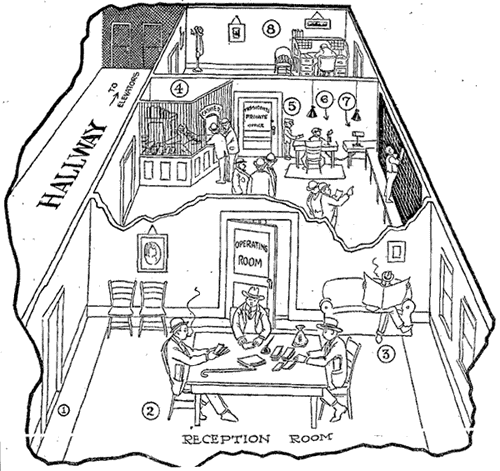
Operating since 1919, the article stresses that it was the establishment of the facility itself, in the Flatiron Building, that drew con men their from across the country. Of course, the "fix" was just as vital, and they had that, too.
The operation, in fact, is described in hyperbolic terms we have often heard associated with the Denver operation, such as calling it the "largest syndicate of professional criminals ever assembled in America."
Con men in this context would often come and go, of course, working in one town under one fixer until things got hot, or cold, or boring, and then it was off to another town, another fixer. The big store facility became a draw in itself, in the same way a fancy convention center draws conventions. A con man and his team could hit a town, work the streets, and have a payoff store available for their use to seal the deal.
By the same token, this adds a touch of trepidation when trying to define the nature of Lou's gang. These men were generally members of their own smaller gangs, who worked under Lou's control when in Denver.
According to the Constitution, the following percentages were national standards:
- Steerer 50%
- Spieler 10%, but much higher volume, working with multiple steerers.
- Store 40%, divided amongst those who ran the store and the incidental players and expenses associated with running it.
(More on these terms and the big store)
Maybe this explains the high percentages often attributed to Lou's share of a given take. These figures, often quoted as high as fifty percent, may have been referring to the cut taken by his organization both for his benefit, and for operating expenses, perhaps even including cuts for his right hand, Kid Duff, a bookmaker, tailer, etc.
Here's W.D. Hill, victim of the Atlanta operation to the tune of $2500.
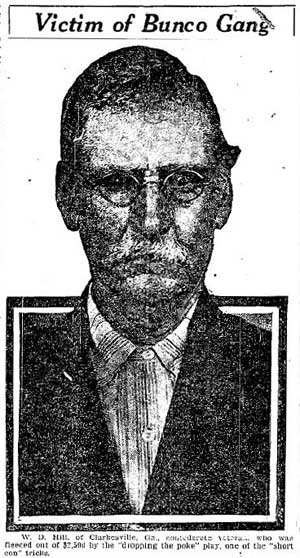
With publicity like this, you can see how folks might be reluctant to report anything.
|
| 9/5/2005 |
The Early Years
Sam and Lou first traveled west from the Chicago area to Red Oak, Iowa with Sam's wife Ella Livingston and her family, including Lou's war buddy William. There, Lou and Sam are listed in the 1870 census working in a hotel and a billiard parlor.
Now, Red Oak is about forty miles from Omaha, and its sister city Council Bluffs. The Chicago, Burlington & Quincy/Union Pacific line passed through both towns.
Further, you will recall that both Denver and Council Bluffs were notorious as protected towns — among a number of other major cities — and that they are remembered as havens for confidence men eager to feed on the tourist trade and business traveler of the day. Later, when John Maybray's Council Bluffs operation went down in 1910, Lou was implicated by paperwork found in Iowa, and he was only saved from prosecution by the intervention of influential friends.
What's more, many grifters would work both towns, under Lou in Denver (by the late 1890s), and under Maybray in Council Bluffs, or someone else in Chicago or Atlanta, or Miami. Lou's manager, Adolph Duff, cut his teeth in Council Bluffs.
Which brings me to my point, I think. While its certainly plausible that Lou first encountered real flim-flam men during the war, or later during his time in Chicago, it's not hard to imagine him learning a thing a two during his time in Red Oak. The following is from a speech about master con man Ben Marks by Ryan Roenfield in 1999:
During this time frame of the early 1870's, Marks was in league with a host of notable gamblers and like-minded confidence men that "roosted" in Council Bluffs and Omaha while sweeping riches away from railroad travelers. This motley group included Canada Bill Jones, a master at three-card monte who was known far and wide for his generosity; Doc Baggs; Charley White; George DeVol; the infamous Frank Tarbeaux, and an Englishman named John Bull who had won infamy in the Montana mining towns for shooting his mentor Charlie Peel dead on Helena's Main Street. In the early '70's, Marks, John Bull, Doc Baggs, and Omaha gambler George Mehaffy were all indicted in Omaha for robbing a Missourian after a card game. Worse yet, the Union Pacific banned gambling on its trains after a now nameless company official lost $1,200 to Frank Tarbeaux and "Jew" Mose. Canada Bill Jones even offered the railroad's general superintendent $10,000 a year for exclusive rights to run three-card monte games on U.P. trains if he limited his victims to Chicago businessmen and Methodist preachers. The Union Pacific declined Canada Bill's generous offer and most of the gamblers sought new opportunities in the mining towns of the Black Hills like Deadwood. But Ben Marks remained in Council Bluffs where he used his ill-gotten wealth to establish himself in politics and turn his transplanted home into a "right town," a place where the fix was covered and "con men gathered for both social and business reasons."
|
| 9/14/2005 |
Park Van Tassell
Today we heard from Gregory LaLonde, who is researching our old friend pioneer aeronaut Park Van Tassell. He contributes the following:
Salt Lake Herald, Friday, May 24, 1889
...A Herald reporter called upon Mr. Van Tassell last evening at the Metropolitan hotel, where he is stopping with his traveling companion and friend, S. H. Blonger, and old-time journalist of Swiss Times fame. The aeronaut is a genial gentleman and answered readily the newspaper man's queries about his career in the air...
S. H., of course, is Sam. This tidbit tells us Sam and Park were friends, and were so well beyond the Blongers' year in Albuquerque, 1882. We knew Park and Lou were drinking buddies, but frankly I wouldn't blame the Professor if he had steered clear of the Blongers after Lou pistol-whipped him that September night 123 years ago last Monday — but what's a little assault between drinking buddies?
And this — "...and old-time journalist of Swiss Times fame..." To whom does this refer? Surely not Sam. And what is the Swiss Times?
By 1889, the Blongers had taken up permanent residence in Denver, in the saloon/gambling house business, with a flourishing numbers racket on the side. It was a year of matrimonial change for the Bros. We have no more specifics for this year beyond Lou's divorce from his first wife Emma, Sam's divorce from his first wife Ella, Sam's marriage to his second wife Sadie, and Lou's marriage to his second wife, Nola. The article above is dated just after Lou's divorce.
Nosing around a bit, Scott turned up these articles on Van Tassell to add to our collection:
Salt Lake Tribune, May 24, 1889
PROF. VAN TASSELL THE AERONAUT.
His Great Experience as an Aeronaut and Some of His Thrilling Perils.
Prof. P. A. Van Tassell, the aeronaut, who is to make the balloon ascension and parachute jump at Garfield Beach to-morrow and Sunday, arrived here from California a few days ago, and has since been busily engaged in completing preparations for his ascensions. Prof. Van Tassell visited Salt Lake in the summer of 1883, and it will be remembered that he made two successful ascensions in July of that year.
A TRIBUNE reporter met the daring balloonist at the Metropolitan last evening, and when asked how many ascension he had made since leaving Zion he replied, "Well, I have traveled all over the United States since then, and have made over 300 ascensions and eighteen parachute jumps."
"You are the originator of the parachute jump, are you not?" inquired the reporter.
"Yes," answered the aeronaut. "It was first attempted at Golden Gate Park, in San Francisco, some two years ago."
"In making so many ascensions, you must have had some thrilling experiences."
"Yes, I have had my share. After leaving here I went up to Oregon and made several ascensions there. On the evening of September 25, 1883, in company with a reporter, I left Portland, and the air carried us directly over a burning forest. The sight, of course, was a grand one, but the situation was an unpleasant one to say the least. If the balloon had come down then it would have been sure death, but we were fortunate enough to make a safe landing and come out unburned, contrary to expectations. From there I went to San Francisco and constructed the 'Eclipse' balloon, and in company with two newspaper men, attempted to make a trip across the continent. We left Central Park, San Francisco, on November 29th, 1884, and on reaching an altitude of about 9000 feet encountered an air current that carried us out over the ocean. After we had gone out some twelve miles the situation commenced to grow desperate, and I let out gas until we dropped to about [?]000 feet, when another current was encountered and we were carried back over Goat Island, and at about 11 o'clock at night we dropped into Raccoon Straight [sic]. After splashing around in the water for some time, a ferry boat picked us up and carried us over to Angel Island. We came so near to becoming angels that the [place?] was quite appropriate. I then went to New Orleans and worked for the Exposition people. On April 15, 188[5?], I left the Exposition grounds, and after sailing over New Orleans, Algiers and other towns, finally landed in a Louisiana swamp. I went tramping around in that swamp for hours, and finally had the good fortune to strike a negro camp. The people took me in and treated me well, and but for them I would not be here to-night. After that experience, I went back to San Francisco and built an "Examiner" balloon, which has a capacity of 75,000 feet of gas. It was constructed for the purpose of taking photographs of the city at an altitude of from [1?],000 to 15,000 feet, and the results were entirely satisfactory. I then went to Seattle, and on January 2, 188[8?], made a jump from the balloon, after realizing a height of 8,500 feet. This was one of the most frightful of all my experiences. When I jumped the straps on one of my hands broke, and this caused the parachute to oscillate in such a manner that I was thrown around like a whip, and came down at an angle of forty-five degrees. I landed in the water, [so?] luckily boats were at hand and picked me up. On February 10th last at Cliff House Beach, I went up to an altitude of about 1500[?] feet and jumped. As I left the balloon my foot caught a rope and I plunged down head foremost. I soon managed to get the parachute over my head, however, and came down all right, as usual, but for a moment I thought it was all up with me."
Prof. Van Tassell received last night a new parachute, thirty feet in diameter. The attachment ropes to this concern, which the Professor unpacked to show the reporter, are thirty-six feet long, and he thinks that by having them this length, he will be able by skillfully oscillating the affair, to land just about where he wants to. He will try for the first time tomorrow.
Originator of the parachute jump?
New York Times, September 14, 1930
USED PARACHUTES FIFTY YEARS AGO.
Captain Van Tassell, 78, of Oakland, Cal., Tells of Early Days as Balloonist.
WIFE ALSO A JUMPER
Los Angeles Chief of Police in 1882 Tried to Prevent Her From "Committing Suicide."
Special to the New York Times.
SAN FRANCISCO, Sept. 13 — One of the first successful parachute jumpers and one of the greatest balloonists of his time, Captain Parks Van Tassel of Oakland is trying to fight his way out of illness and bad luck after a career as an aeronaut in all parts of the world extending over fifty-one years. He is 78 years old.
"My first experience with a balloon was in the days when I was a barefoot boy on a farm in Ohio," he relates.
"I had seen a balloon ascension at a fair and together with neighbor boys resolved to have a balloon of my own. This, we constructed of paper according to what we had seen of the big balloon.
Mr. Van Tassel told of one of his first ascents when he had taken up the profession of balloonist.
"It was at Albuquerque, N. M., in 1879," he recalled. "The town was just beginning and the gas plant from which I filled my balloon was so weak it took two days to fill the balloon, during which the customers went without heat or light. But they were willing as it was the first ascension they had seen. Needless to say, I was the hero of the hour."
His Wife a Parachute Jumper.
His wife was one of the first women to make a parachute jump This was in Los Angeles on July 4, 1882, and, Mr. Van Tassel recalled, the town was thrown into an uproar, the Chief of Police championing "the good people of this town who are determined no woman shall be allowed to commit suicide on a national holiday."
"But the Mayor and a number of influential and clever persons were on my side," Mr. Van Tassel said. "So my wife went up with me and the jump was successful."
Of his own first venture in this field, he said:
"I built my first parachute from a picture in the dictionary. Parachutes had been known of course for years. In fact, men had made descents in them in France, but these were so frequently fatal that the parachutes were known as man-killers and balloonists restrained themselves with dropping at most a live pig. But I figured, if a live animal, why not a live man.
"Needless to say my parachute and my jumps with it were successful."
Became Tangled in Parachute.
In 1889, he had one of the closest calls of his career in a jump near the Cliff House in San Francisco. He leaped from a balloon and part of the parachute opened. But his legs were entangled and, according to a news clipping of the day, "the spectators were horrified to see him falling to apparent certain death."
But he kicked loosed, the parachute opened and he alighted at the edge of the tide, while the crowd cheered.
His longest flight was in 1883, in Salt Lake City. He was in the air six hours and forty-five minutes and traveled about 300 miles.
He met with all sorts of adventures on his travels. Once, in Siam, he alighted in a mulberry tree. Another time he was threatened by fanatics in India who feared he would "get them in bad" with the devils of the upper air.
In Hawaii, on his first world tour, he lost his professional brother, Joseph Lawrence, known to the public as one of the Van Tassel Brothers. Lawrence landed four miles at sea in shark-infested waters.
A set of battered scrapbooks, which have traveled thousands of miles on camels, elephants, trains, ships, and all sorts of conveyances, is a mine of material on the adventures of the nineteenth century aeronaut.
He's got his years a bit muddled. Albuquerque was 1882, not 1879. The gas plant was completed that year, just prior to the ascent on July 4. He also calls it one of his first ascents, though at the time he was described as an experienced baloonist already on at least his second baloon.
Says here the Van Tassell eaten by sharks off Hawaii was his "professional" brother. Huh.
And where the heck is that scrapbook?
|
| 9/15/2005 |
Sam and Park Van Tassel
Here's a quick recap of Lou Blonger's older brother Sam's bio:
Around the year 1858, at the age of eighteen, Sam accompanied a wagon train west in search of wealth and adventure. He spent the war years in California, Nevada and Colorado. It was said that he spent time as a teamster trucking supplies from Sacramento over the Sierras to the mining camps of Western Nevada. He may also have done some prospecting. Brother Joe would later contend that Sam was a scout with a young Bill Cody for a time, though this claim is without substantiation. Joe himself claimed to have been a scout with Cody during the Indian Wars.
Returning to the Midwest after the war, Sam teamed up with his brother Lou, Sam's new wife Ella, and Ella's family, and went West to Iowa. Here began their twenty-year road trip through the West, owning saloons, gambling houses, theaters and other businesses in one boomtown after another. Salt Lake City, Stockton, Dry Canyon, Silver Reef, Tuscarora, Cornucopia, Virginia City.
We have few details from this period, though the general consensus is that they served booze, supplied women, hosted gambling, prospected, and assisted now and then in keeping the peace — being as it was in the interest of all good businessmen.
From 1879 till 1881, Sam and Lou were in the Leadville area, along with Holliday, Masterson, and others. Sam ran for mayor, and lost. Lou ran a theater in nearby Georgetown.
By 1882 the brothers were in Albuquerque, where Sam was appointed marshal. Lou served as his deputy when needed. During this time they were probably involved in the local bunco racket, and Sam's position was probably useful in this respect.
During this time, Sam and Lou both faced danger on numerous occasion, and were said to have handled the circumstances with aplomb, managing somehow to avoid bloodshed during his short tenure in the hardscrabble town that had grown up around the newly arrived railroad.
It was an interesting year in Albuquerque, but two particularly notable events occurred: Park Van Tassel's ascent on the Fourth of July, the first ascension in New Mexico, and the brief visit in April of Wyatt Earp and his posse, including Doc Holliday, as they sought to avoid the authorities in Arizona.
Here we know Lou was a drinking buddy of Van Tassel. Lou beat the Professor with his pistol one night when VT said something inappropriate to the "madam" of the house, Lou's "woman."
We had no earlier indication that Sam and Park were friends. What's more, we never had any indication that Sam was a writer of any kind. Perhaps that would explain why the political machinations of the Blonger Bros. were so often mentioned as though no further explanation was called for. Where's that newspaper, the Swiss Times!
I think it's instructive that they should be friends for such a long time. Everyone spoke highly of Park. And the Blongers also had more than their share of friends — some well-paid certainly, but many apparent abiding friendships. Make no mistake, Lou and Sam could both be brutal men. They did not suffer much of anything they dispproved of, like other prominent men and women of the West, but they did have a legion of loyal friends in high places.
Could Sam have been a partner in any of VT's ventures? The Blonger's were no strangers to show business. And nobody was more mobile than the Blonger Bros. — except maybe an aeronaut like Van Tassel.
Was Van Tassel a swindler? We have no suggestion that Park was predisposed to that sort of behavior, besides the company he evidently kept.
Earp's stay in town was uneventful — the local papers even agreed to keep mum, though the posse's flight was national news — but the visit is nevertheless of great interest to our story, as there are indications Earp and/or Holliday may have sought refuge in Albuquerque precisely because they knew Sam, Lou, and others were in charge.
After 1882, Sam appears to have headed back to Colorado where he raced horses (certainly), speculated in mining (assuredly), gambled to much (undoubtedly), and continued to work in some capacity as a lawman or private detective (supposedly, quite possibly). Sam lost an eye during a gunfight at some time in his life, probably during the late Eighties in Denver, perhaps as a peace officer or a dick.
By the 1890s, Sam and Lou were prosperous owners of saloons and gambling houses in Denver. Sam had his racehorses, and there was the Forest Queen near Cripple Creek, pumping out gold. Their connections to law enforcement served the brothers well. By the turn of the century, they had a lock on the town, and could order the arrest or release of any mug they wanted, and with this power they sold their protection to the bunco men that infested Denver's downtown. By this time, no con man worked the streets of Denver without paying his due to the Blongers.
And there were a lot of con men, in highly organized — almost genteel — gangs of men executing complicated swindles like the wire, and the rag, in which a sucker eventually coughs up a huge wad of cash, supposedly to secure the delivery of a huge sum of money that he has already won, with no investment! The wire, of course, was depicted fairly faithfully in The Sting.
Lou and Sam made possible a vast criminal enterprise that prospered unimpeded for over twenty-five years. It finally ended with Lou's spectacular arrest and trial in 1922. But Sam dodged that bullet, having died of disease in Denver in 1914.
|
| 9/16/2005 |
The Sting
Scott found an interesting article, 1982, about the con depicted in The Sting. It seems that once the movie was a hit, David Ward, who wrote the screenplay, was sued by David Maurer, author of the book The Big Con. It seems Mr. Maurer believed the movie was based on his description of the wire con, and that he should be entitled to his fair share of the movie's profits.
Ward countered that the claim was absurd. He had, in fact done his homework, reading several books on the subject, including Fighting the Underworld, Philip Van Cise's book on the Blonger gang and the arrest thereof.
(In the movie, one can barely hear Kid Twist ask, as he banters with another con man waiting to volunteer for the upcoming con, if he remembers the day back in Denver...)
For our part, we've found a few newspaper articles on the subject as well, some pre-dating any of the books.
While Ward's point was hard to argue, the studio hedged its bet and settled the suit for $350,000.
Clara and John Belonger
Two of Mike's ten kids, Clara and John. Neither ever married, remaining on the family's tiny farm, tending to father until his death.
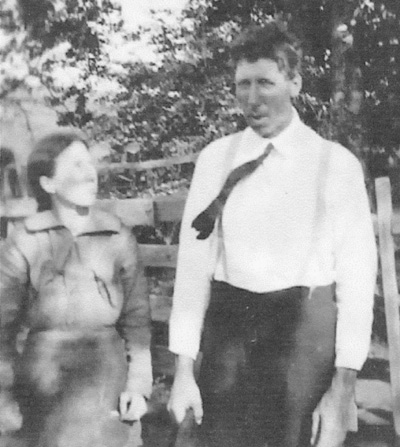
Is it just me, or does he have the look of giantism?
|
| 9/17/2005 |
Property For Sale
These all from the same page of the Indianapolis Sunday Star, May 26, 1918.
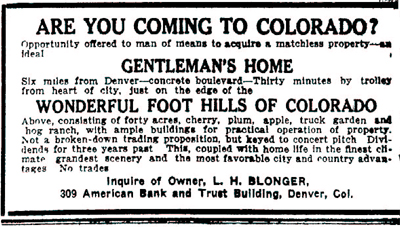
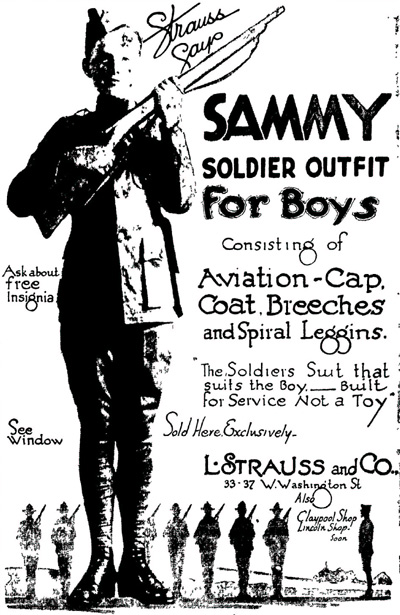
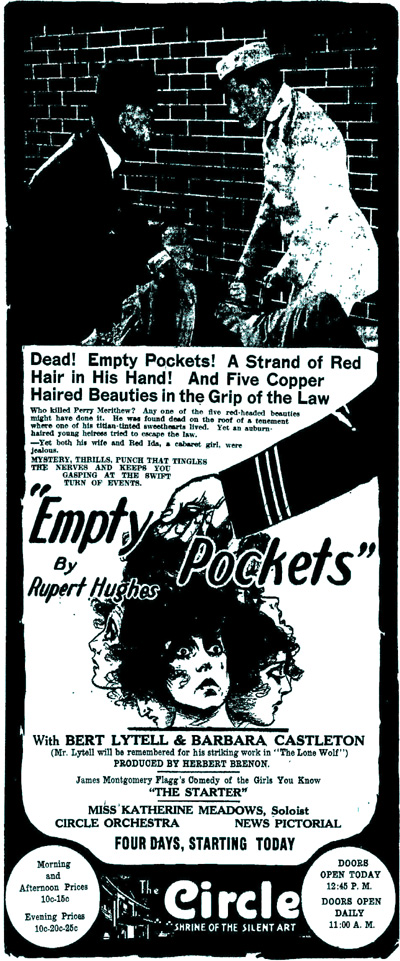
The Fixers
More in response to Gregory LeLonde:
My suspicion is that the Swiss Times was one of many local rags, probably of special interest to Swiss immigrants, and probably with a decided political agenda. I'm guessing Sam had some kind of column on politics — if the reference is to be believed at all. I wouldn't put it past Sam to pull the reporter's leg.
As to the Blongers hold on Denver — this subject is really at the heart of our research. Much of the literature we have found from the late teens on state quite plainly that Lou had influence in Denver that bordered on absolute. While I'm sure this is hyperbole, I think the point is that when it came to the bunko trade, Lou controlled both who could practice in town, who couldn't, and who stayed in jail or got out after being arrested.
He also seems to have had great influence on elections, being able to command the votes of dozens or hundreds of local low lifes, as well as being able to place his minions in polling places to stuff ballot boxes and intimidate voters. Not to mention the kind of money he could funnel into a campaign. This was eventually his downfall. He offered Van Cise, candidate for DA, a hefty sum for his campaign. Van Cise was insulted, and after his election he decided to bring down Lou's organization.
Interestingly — Van Cise never would have been elected had not the Republican ticket been split by competing candidates from the city machine and the state machine. Reformer Van Cise slipped under the wire and took the candidacy in the primary.
The bunko industry was far bigger and more powerful at the time than is generally recalled today. Railroad towns across the country — mining centers and tourist destinations, above all — were infested with bunko gangs, and each one had someone to call when they got hauled downtown. These gangs quite efficiently relieved travelers of large sums of money, and pumped that "imported" cash it into the local economy — and the coffers of the politicians. Businessmen and pols alike valued bunko gangs and gambling houses in much the same way communities today covet casinos.
At the same time, any major city that had a thriving gambling/bunco trade had fixers, like Soapy Smith in Creede, Denver and Skagway, or Maybray in Council Bluffs. These guys kept everybody happy, by providing bribes to the politicians and cops, and providing protection from real incarceration to the con men.
Lou was one of many who had this function across the country, but he may well have been the most successful, operating largely untouched for over twenty-five years. Con men all over the country are said to have called Denver under Lou the Big Store, the safest and most lucrative town in which to operate.
|
| 9/18/2005 |
Doc Baggs
Today we heard from Jim Baggs, who doesn't believe he is related to Doc, but is keenly interested in the subject. Jim's family is from Iowa, where Doc started out, so who knows?
|
| 9/22/2005 |
New Project
Guess what we're working on...
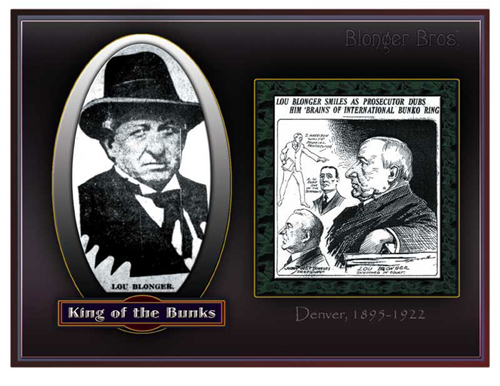
Jenny Van Tassel
The National Police Gazette, August 11, 1888
MRS. PROF. VAN TASSELL
Mrs. Van Tassell recently at Los Angeles, Cal., made one of the most daring and successful balloon ascensions and parachute descents ever witnessed. She left the balloon when 6,000 feet high, and landed safely on a sandy field about a mile from where the ascent was made.
|
| 9/29/2005 |
New Project
Here's another peek:
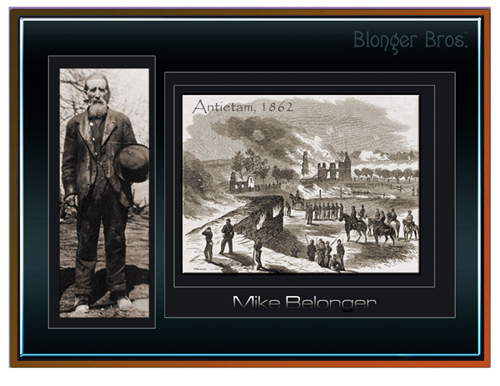
A few random bits from ABQ
The Burros
While perusing the exhibits in the Palace of the Governors in Santa Fe, I came across an anonymous poem on the wall. The poem described the fate a many a burro in mining country, being lowered down into the mines to pull the ore carts. It was stated, and I am taking the poet here at his word, that the animals were not hauled back out every day, or week, or month. One burro, supposedly, worked in a mine for seventeen years. Some of the miners were said to feel deeply for the plight of these animals, but could not bear to haul them up, as they would never get them back down again. How utterly sad.
Milt Yarberry
While at the university library in Albuquerque, we came across many articles on Milt Yarberry, and I wish I had copied them. Milt was New Albuquerque's first marshal.
Yarberry's claim to fame was a penchant for killing dangerous men whether they were armed or not. He thought the businessmen of the town, who paid his salary, would thank him for his trouble, but instead he wound up at the end of a rope. In fact, the device used to hang Yarberry was a new-fangled gallows, the design for which was derived from an article in Scientific American. The device turned the traditional gallows on its head — the prisoner was yanked off his feet by a heavy weight at the other end of the rope, rather than relying on the man's weight to break his own neck.
Yarberry was in prison during Sam's tenure as marshal, and was executed in February of 1883.
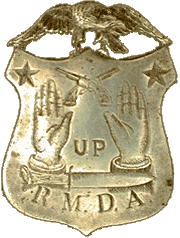
What I found particularly interesting were the words of the judge in Yarberry's case, as quoted in the local paper. This is just theorizing on my part, of course, but I got the impression the judge wanted to create a precedent in the case by saying that lawmen should always utter the phrase "Throw up your hands!" when making an arrest. This would give the arrestee notice that he was being addressed by a lawman, and not simply being accosted by an armed man, and that if he complied he would not be in danger of being shot.
Sam was reported to have uttered the phrase at least once, and it was also the slogan of the Rocky Mountain Detective Association.
On the other hand, we now know it became common practice for holdups to say the same thing or similar, as a warning to refrain from going for your gun.
|
| 9/30/2005 |
New Book
Oh goody. Outlaw Tales of Colorado : True Stories of Colorado's Most Famous Robbers, Rustlers, and Bandits (Outlaw Tales Series) just shipped. Cool.
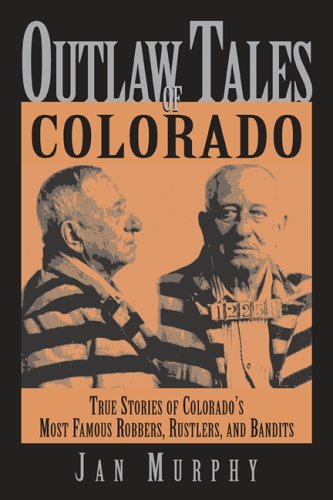
I just recently heard that one of my childhood buddies, Coleman (Scott) Miller, just won at the Ann Arbor and Humboldt film festivals for his recent film Uso Justo (Fair use). Bravo, homeboy.
And I'll tell you what I told him:
The history of the West isn't about cowboys, who mostly herded cows. How many actual, real cowboys (who actually herded cows) can you name?
It's about gold & silver, the miners who went from region to region in swarms looking for it, leaving small towns and rails in their wake, the men who followed to sell them booze, women and a place to gamble, the gamblers and con men who extracted money from travelers and pumped it into local pockets and tills and poker games, the soldiers who removed the Indians so all this could take place, and finally the merchants, familes, children, churches that followed, and finally demanded an end to the debauchery and lawlessness. Lou and older brother Sam were in fact two of those figures, like the Earps or Bat Masterson, who were apparently hired on several occasions in various locales to be lawmen and private detectives — men tough enough to ride herd on the roughest customers in a town full of rowdy, drunken prospectors and gamblers and layabouts.
|
September 2005
|
Genealogy - History - Gang - Posse - Evening Review
The Grafters Club - Blonger Bros. Fake Restaurant
|
Copyright Notice: Original material copyright 2003-2021 Scott Johnson and Craig Johnson. Other copyrights may apply to materials found herein. Our primary goal is to reintroduce the Blonger Bros. to the lexicon of the Wild West. We therefore encourage the use of our research, provided due credit is given.
https://www.blongerbros.com
|
|



